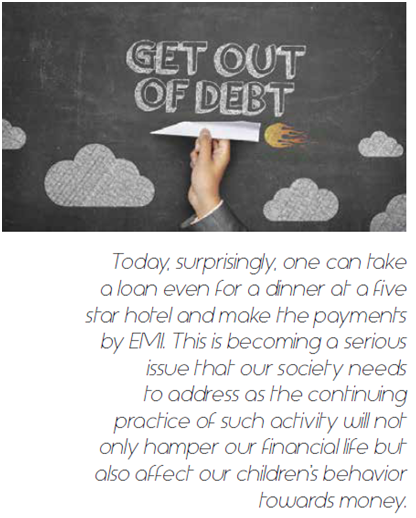
Rajib’s family was excited about getting new furniture, curtains and even a beautiful showpiece for their living room, just before Diwali. However their excitement soon turned to anxiety when they realised that the probable price of all this would be around Rs. 100000/. They knew, that they could charge the entire amount to their credit card. But after a little discussion among themselves they came up with another possible way to fund this home improvement — taking a Personal Loan.
In both the cases the way to achieve their dream was only by borrowing, either by credit card or a Personal Loan. Because Rajib and his family had fixed monthly expenses, they could not afford to pay more than Rs. 3000/- additionally, after meeting their monthly obligations. So opting for a loan was the only choice they had — the EMI (Equated Monthly Installment) option.
 EMI has become a household word across the country and its promotions are tagged to every product and even services today. Advertisements act as a strong reminder of this financial panacea to realise materialist dreams, just like for Rajib and his family.
EMI has become a household word across the country and its promotions are tagged to every product and even services today. Advertisements act as a strong reminder of this financial panacea to realise materialist dreams, just like for Rajib and his family.
EMI is nothing but a loan or debt designed in such a way so as to woo consumers during decision making about purchases. The concept of EMI holds good not only for Rajib and his family but also for more and more people in our society. The number of those who have accepted this practice as an ultimate way to satisfy their wants and desires is engulfing our population at an exponential rate.
Is this really the way to satisfy our material desires, by taking loans, or is it becoming just Debt Addiction?
Herbert A. Simon, the American economist and a Nobel Prize winner remarked, “a decision maker did not always make the best financial decision because of limited resources and personal inclinations”.
Lending has existed for thousands of years and has taken on many forms. Traditional Loan can be traced back to the beginning of civilization. Basically grain loans were given to farmers and traders who carried goods between cities. This began around 2000 BC in Assyria in northern Mesopotamia.
Mortgages were developed for the real estate or property buyers just 100 years back. This kind of a loan is called ‘good debts’ as they create value in the long run.
But the generic purpose of loans has drastically changed down the line since ancient times, primarily because of its easy availability with upgraded technology. The mindset of buying every product by borrowing is gaining popularity by leaps and bounds.
Even in India up to 30 years ago, society at large never thought of taking multiple loans to fund their household goods like washing machines, TV’s, two wheelers , smart phones or even clothing. This trend is not a healthy sign as the financial stability of most households is in question, today.
Even big decisions of once in a lifetime buying, like homes, have some interesting statistics. HDFC was the first organized player in the Home Loan market. The average loan amount was Rs. 30000/- to build a project of Rs. 70000/- in Mumbai‘s Malad area, way back in 1978, meaning that around 43 % was self-funded by the borrower. Borrowers never thought to fund their house by 80 % through a loan as they do today.
Today, surprisingly, one can take a loan even for a dinner at a five star hotel and make the payments by EMI. This is becoming a serious issue that our society needs to address as the continuing practice of such activity will not only hamper our financial life but also affect our children’s behavior towards money.
The mindset has changed over a period of just a few years in financial decision making, especially during the making of purchases. We are satisfying not just our needs here, but our desire to possess all the goods out there, being advertised day and night, luring us to buy them, posing themselves as things which will make us happy. And paying for them, all through EMI. It is an illusion that we can enjoy all the luxury of life at this cost when, in fact, we are paying a price significantly higher than the published MRP. The following points may open up our minds to understand how loans and debts are actually bad financial practices and deteriorate our financial health.
Rajesh Choudhury
To read the further articles please get your copy of Eastern Panorama June issue @http://www.magzter.com/IN/Hill-Publications/Eastern-Panorama/News/ or mail to contact @easternpanorama.in

